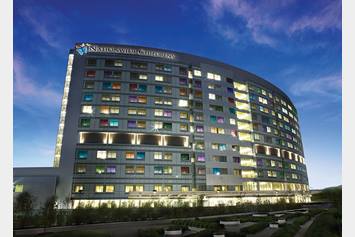Tinea Versicolor
Tinea versicolor is a common fungal skin infection that causes discolored patches on the skin. It is not contagious and can be treated with antifungal medications.
Tinea versicolor, also called pityriasis versicolor, is a common, benign (harmless) skin rash. It is caused by a type of fungus (yeast) that all people have on their skin. The fungus can grow out of control in teens and young adults who have oily skin, hormonal changes (puberty), sweat a lot, or have a weak immune system.
- When the fungus grows out of control, it forms patches of different colors on the skin. The patches:
- Can be lighter or darker than your normal skin.
- Can be small, scaly, and a little itchy.
- Show up mostly on the upper arms, chest, back, and neck.
- Tinea versicolor is more common in hot, humid weather. Being in the sun or sweating a lot can make it worse.
- You can’t give it or spread it to others. The rash is not contagious.
Diagnosis
To diagnose your child’s rash, their doctor or health care provider may:
- Look at the rash with a special ultraviolet (UV) light called a Wood lamp.
- Scrape off some of the rash to look at under a microscope.
Treatment
- The type of treatment depends on where the rash is and how bad it is. Your doctor or health care provider will suggest names of products to use.
- Mild cases can sometimes be treated with over-the-counter (OTC) topical (on the skin):
- Anti-fungal creams and lotions
- Shampoos with selenium sulfide
- More severe cases may be treated with prescription topical and/or oral (taken by mouth) medicines.
- Creams and lotions need to stay on your child’s skin for 5 to 10 minutes before rinsing them off.
- It may take many weeks or months for tinea versicolor to go away and for your child’s skin color to go back to normal.
- The rash can come back, especially when it’s warm and humid outside.
- Sometimes, people need to treat their rash a few times a year.
What to Do at Home
- To keep the skin cool and dry, have your child:
- Wear loose-fitting, dry cotton clothes. Change clothes if they become damp.
- Shower after activities that make them sweat.
- Use warm, not hot, water.
- Thoroughly rinse the soap off, dry the skin well, and use a clean towel each time.
- Avoid steam showers.
- Avoid using oily skin products.
- Protect your child’s skin from the direct sun.
- Call your child’s doctor or health care provider if the rash gets worse, even with treatment.
Helping Hands™ Patient Education Materials
Helping Hands™ are easy-to-read guides about different illnesses, therapies, surgeries, and more. They’re created by the Patient Education team at Nationwide Children’s Hospital and are reviewed and approved by clinical staff, like nurses, doctors, pharmacists, and psychologists. Nationwide Children's Hospital is not responsible for misuse of information in patient education materials, including Helping Hands™.
HH-I-384 | ©2015, revised 2024, Nationwide Children’s Hospital


